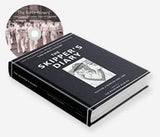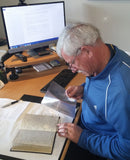For international orders there are other payment and delivery options, please contact us
This is a story that will be enjoyed by more than just those who love the game of cricket. The Second World War ended in 1945 and Europe faced many challenges. By 1949 England was still recovering and rebuilding their severely damaged country. It was the “Age of Austerity” where food and fuel supplies were still being rationed. There were strikes and life for the majority of people was not easy.
1949 was also a significant era and many changes were occurring throughout the world. The Geneva Convention was agreed, Apartheid began in South Africa, Harry Truman was President of the United States, The Peoples’ Republic of China was proclaimed by Mao Zedong, the Republic of Ireland withdrew from the British Commonwealth, the UN Security Council recommended membership for Israel, Siam renamed itself Thailand, and Donald Bradman, the world’s greatest batsman played his last first class innings, scoring 30.
The English public had now turned their attention to sport to get respite from their daily lives of labour and negativity. Previous New Zealand tours had been unsuccessful and lost money but now it was time for the New Zealanders to make an impression and earn respect and credibility as a cricket playing nation.
No other team in the history of New Zealand Cricket were known by the year in which they played. ‘The Forty-Niners’ were a special group of players, who developed a great team spirit and bond throughout the eight month tour. They played 32 first class games, winning 13, and drawing all four Test matches against England which was a significant achievement. They lost only one of the 37 games played.
The commitment made by these men and their families was huge. Eight months away from their homes, time taken off work and potential loss of income, was significant. They were paid a daily allowance of one pound throughout the tour.
Today we think nothing of travelling to the other side of the world in 24 hours. In 1949 long distance flying was not an option. It wasn’t until 1965 that Air New Zealand flew as far as the USA. Travelling by ship, trains, coach and car was the mode of transport during the tour. Staying in modest hotels with constant packing and unpacking bags was often tiresome.
Walter kept an in depth daily diary that encapsulates the whole experience of travelling by ship for six weeks from Wellington to England and writing about life on board the Dominion Monarch. His detailed writings include the team’s preparation, playing all the games, team selections, team meetings, speeches he made, sightseeing, factory visits and the people he and the team met including royalty. The team also became great ambassadors for New Zealand and helped to develop trade and business contacts. Then there was the 5 week trip home travelling on the Rangitata via the Panama Canal. Walter said, “I would have paid to have gone on that tour because of the experiences I would have.”
As youngsters we grew up hearing Walter tell stories about the tour and the lifelong friendships he made. He had an uncanny way of being able to weave stories and references of the tour into almost any conversation, much to our amusement as adults. The bond Dad felt for his teammates never left him and if anything the love grew stronger over the years that followed.
Included with the book is a complimentary two hour DVD documentary of the tour called ‘The Forty-Niners’ introduced by Sir Richard Hadlee. The documentary includes reflective player interviews from Walter Hadlee (also reading from his own diary), Martin Donnelly, John Reid, Merv Wallace, Johnny Hayes, Bert Sutcliffe, and comments from Don Neely. The current Blackcaps coach, Mike Hesson, and captain, Kane Williamson also share their views on ‘The Forty-Niners’. There is archive black and white film footage of the tour and a selection of tour photographs and asides.
$10.00 shipping throughout New Zealand











